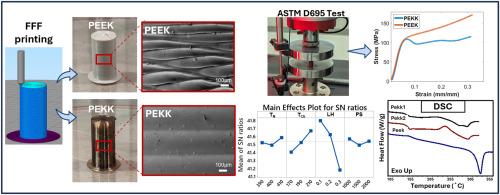Optimization of fused filament fabrication process parameters to improve the compressive properties of PEEK and PEKK biomaterials
IF 3.5
2区 医学
Q2 ENGINEERING, BIOMEDICAL
Journal of the Mechanical Behavior of Biomedical Materials
Pub Date : 2025-09-16
DOI:10.1016/j.jmbbm.2025.107203
引用次数: 0
Abstract
Fused filament fabrication (FFF) is increasingly being adopted to create polymeric orthopedic devices. FFF process parameters determine the mechanical performance of final printed parts; hence, optimizing for appropriate levels of strength is critical for load-bearing applications.
We utilized a Taguchi L-9 orthogonal array to investigate the impact of nozzle temperature (TN), chamber temperature (TCh), layer height (LH), and print speed (PS) on the compressive properties of cylindrical polyether-ether-ketone (PEEK) and polyether-ketone-ketone (PEKK). The printed specimens were examined using optical microscopy, scanning electron microscopy, and differential scanning calorimetry to understand the effect of the printing parameters on their macrostructures.
The optimized parameter combination for the elastic modulus (E) of PEEK and PEKK was 390 °C TN, (190 °C–PEEK, 110 °C–PEKK) TCh, 0.1 mm LH, and 1000 mm/min PS, with LH and PS having the most impact on their stiffness. For the offset yield strength (YS), the optimized parameters were (410 °C–PEEK, 400 °C–PEKK) TN, (210 °C–PEEK, 150 °C–PEKK) TCh, 0.1 mm LH, and (1000 mm/min–PEEK, 1500 mm/min–PEKK) PS, with TN, TCh, and LH significantly impacting both materials.
Elevated thermal conditions enhanced the strength of both materials; however, in PEEK, this was achieved by slowing down its crystallization kinetics, while in PEKK, it increased tendency for crystallization. The print conditions significantly affected the crystallinity of PEKK but not PEEK. Additionally, the highest E of PEEK and PEKK were 113 % and 106 % of the expected value of unreinforced PEEK (3.3 GPa), whereas the highest YS were 132 % and 120 % higher (94 MPa), respectively, indicating PEKK's potential for spinal cage applications.

优化熔融长丝制备工艺参数,提高PEEK和PEKK生物材料的压缩性能
熔融长丝制造(FFF)越来越多地被用于制造聚合物矫形装置。FFF工艺参数决定最终打印件的力学性能;因此,优化适当的强度水平对承重应用至关重要。利用Taguchi L-9正交阵列研究喷嘴温度(TN)、腔室温度(TCh)、层高(LH)和打印速度(PS)对圆柱形聚醚醚酮(PEEK)和聚醚酮酮(PEKK)压缩性能的影响。采用光学显微镜、扫描电镜和差示扫描量热法对打印样品进行了检测,了解打印参数对其宏观结构的影响。PEEK和PEKK弹性模量(E)的优化参数组合为390°C TN,(190°C - PEEK, 110°C - PEKK) TCh, 0.1 mm LH和1000 mm/min PS,其中LH和PS对其刚度的影响最大。对于偏移屈服强度(YS),优化参数为(410°C-PEEK, 400°C-PEKK) TN、(210°C-PEEK, 150°C-PEKK) TCh、0.1 mm LH和(1000 mm/ min-PEEK, 1500 mm/ min-PEKK) PS,其中TN、TCh和LH对两种材料都有显著影响。高温条件增强了两种材料的强度;然而,在PEEK中,这是通过减缓其结晶动力学来实现的,而在PEKK中,它增加了结晶倾向。打印条件对PEKK结晶度有显著影响,对PEEK结晶度无显著影响。此外,PEEK和PEKK的最高E值分别为未增强PEEK的预期值(3.3 GPa)的113%和106%,而最高YS值分别为132%和120% (94 MPa),表明PEKK在脊柱cage应用中的潜力。
本文章由计算机程序翻译,如有差异,请以英文原文为准。
求助全文
约1分钟内获得全文
求助全文
来源期刊

Journal of the Mechanical Behavior of Biomedical Materials
工程技术-材料科学:生物材料
CiteScore
7.20
自引率
7.70%
发文量
505
审稿时长
46 days
期刊介绍:
The Journal of the Mechanical Behavior of Biomedical Materials is concerned with the mechanical deformation, damage and failure under applied forces, of biological material (at the tissue, cellular and molecular levels) and of biomaterials, i.e. those materials which are designed to mimic or replace biological materials.
The primary focus of the journal is the synthesis of materials science, biology, and medical and dental science. Reports of fundamental scientific investigations are welcome, as are articles concerned with the practical application of materials in medical devices. Both experimental and theoretical work is of interest; theoretical papers will normally include comparison of predictions with experimental data, though we recognize that this may not always be appropriate. The journal also publishes technical notes concerned with emerging experimental or theoretical techniques, letters to the editor and, by invitation, review articles and papers describing existing techniques for the benefit of an interdisciplinary readership.
 求助内容:
求助内容: 应助结果提醒方式:
应助结果提醒方式:


